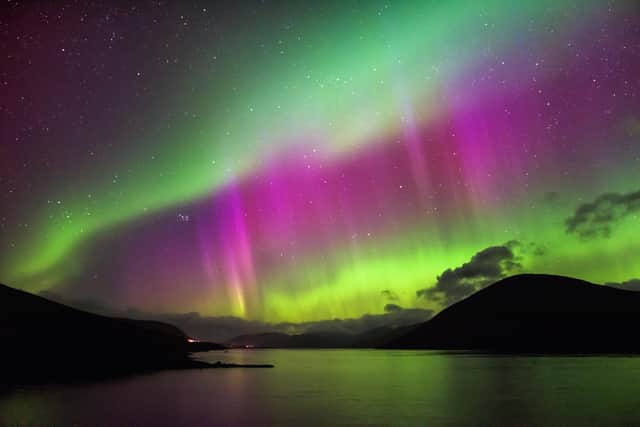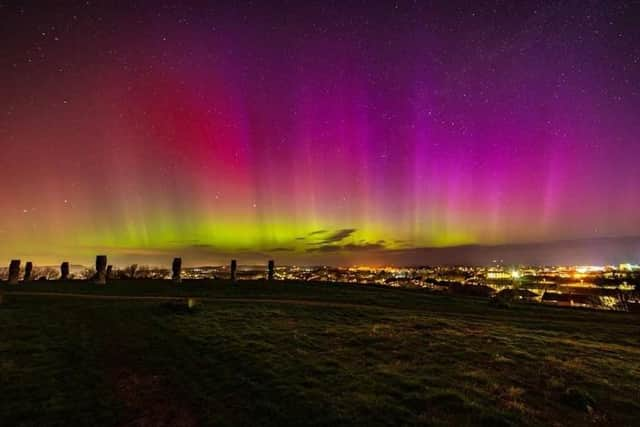Aurora borealis: will northern lights be visible in UK tonight, how to see in Scotland - Aurora Watch forecast
and live on Freeview channel 276
The Met Office has said that the Northern Lights may be visible in parts of the country this evening (24 April).
Earlier this year, the lights were visible throughout the UK and were even seen in locations much further south than when they usually appear, like Cambridgeshire, Shropshire, Hertfordshire, and even Cornwall.
Advertisement
Hide AdAdvertisement
Hide AdAt the time, the national weather service explained that the brightness of the lights was down to heightened solar activity, tweeting: “A coronal hole high speed stream arrived this evening combined with a rather fast coronal mass ejection leading to #Aurora sightings across the UK.”
Dozens of spectators shared spectacular - and not so spectacular - images of their sightings across social media, with one sharing a picture from just outside London.
The Met Office has said the Northern Lights will be visible again on Sunday and Monday (23 and 24 April), clear skies permitting. But will the celestial lights be visible where you live? Here is everything you need to know about it.
Will the northern lights be visible again?


The Met Office has said that the aurora will be visible in parts of the country on Sunday (23 April), and then again on Monday (24 April).
Will they be visible across the UK?


Advertisement
Hide AdAdvertisement
Hide AdOn Twitter, the Met Office advises: “In Scotland and northern England you may be able to spot the #Aurora Borealis tonight, though there will be too much cloud for most Clearer skies tomorrow night mean there will be a greater chance for some good views.”
Earlier this year, a solar storm led to a colourful spectacle seen across the country, AND Britons were treated to a spectacular show when the Aurora Borealis was visible as far south as Kent and Cornwall.
How to see the northern lights?
The northern lights, also known as aurora borealis, are a natural light display caused by charged particles from the sun colliding with the Earth’s atmosphere. When these charged particles collide with the gases in our atmosphere, such as oxygen and nitrogen, they release energy in the form of light.
Auroras usually occur in a band called the annulus (a ring about 1,865 miles across) centred on the magnetic poles. Seeing the aurora borealis is usually something people travel to the most northern parts of the world to see, like Iceland and Norway.
Advertisement
Hide AdAdvertisement
Hide AdBut the arrival of a coronal mass ejection from the sun can cause the annulus to expand, bringing the aurora to lower latitudes. It is under these circumstances that the lights can be seen in the UK.
Though the aurora borealis is active year-round, and its strength can be increased by solar activity at any time, the chances of seeing the lights vastly increase throughout the autumn and winter months, when the nights are longer and darker.
You are more likely to get a good sighting around midnight, and of course you’ll need a clear sky for the best. It’s also best to avoid nights when there is a full moon, as the light from the Moon can dampen the aurora’s effect.
It might seem obvious, but you’ll need to look north to see them. Though they have been spotted in recent days in more southern areas of the UK, the lights still emanate from the north, so turn in that direction. Ideally, you’ll want a low horizon unobscured by buildings or geographical features like hills.
Advertisement
Hide AdAdvertisement
Hide AdTry to get as far away from the light pollution of towns and cities as you can, and make sure you keep an eye out for unusual light patterns in the sky. Sometimes it can look like a slight flicker of colour, other times you will have no doubt it’s the auroras.
Check the weather forecast and keep an eye on websites like AuroraWatch UK which can help you identify peak times for viewing.
The most spectacular pictures of the aurora borealis are usually captured with a long-exposure, which leads many people to expect the brilliantly green trails of light snaking eerily across the night sky. In actuality, the lights might look like a faint film of mist to the naked eye.
Using a long exposure to capture the aurora on camera necessitates the use of a tripod to keep your camera steady, but you can get some spectacular results when exposing for around 20-30 seconds.
Comment Guidelines
National World encourages reader discussion on our stories. User feedback, insights and back-and-forth exchanges add a rich layer of context to reporting. Please review our Community Guidelines before commenting.
